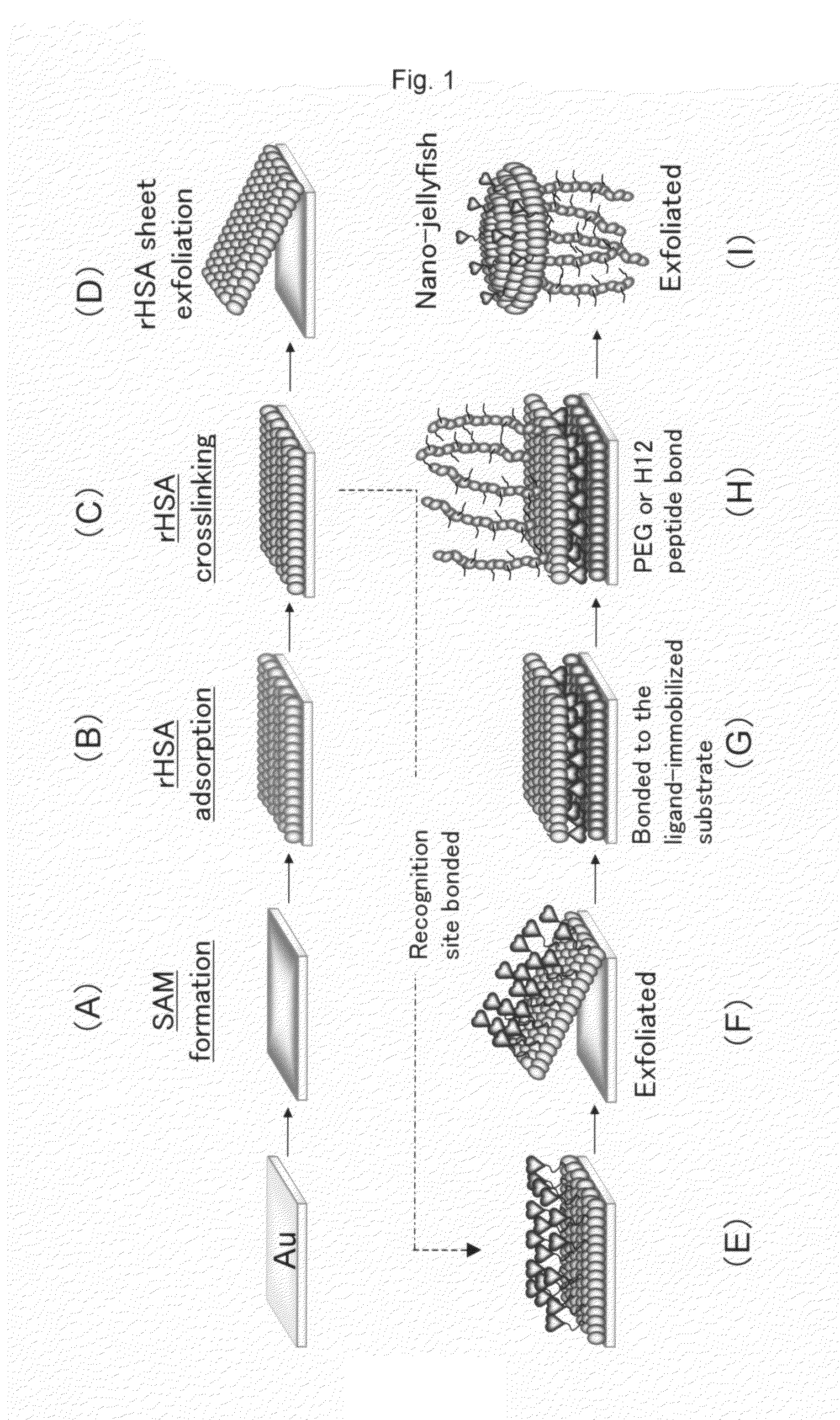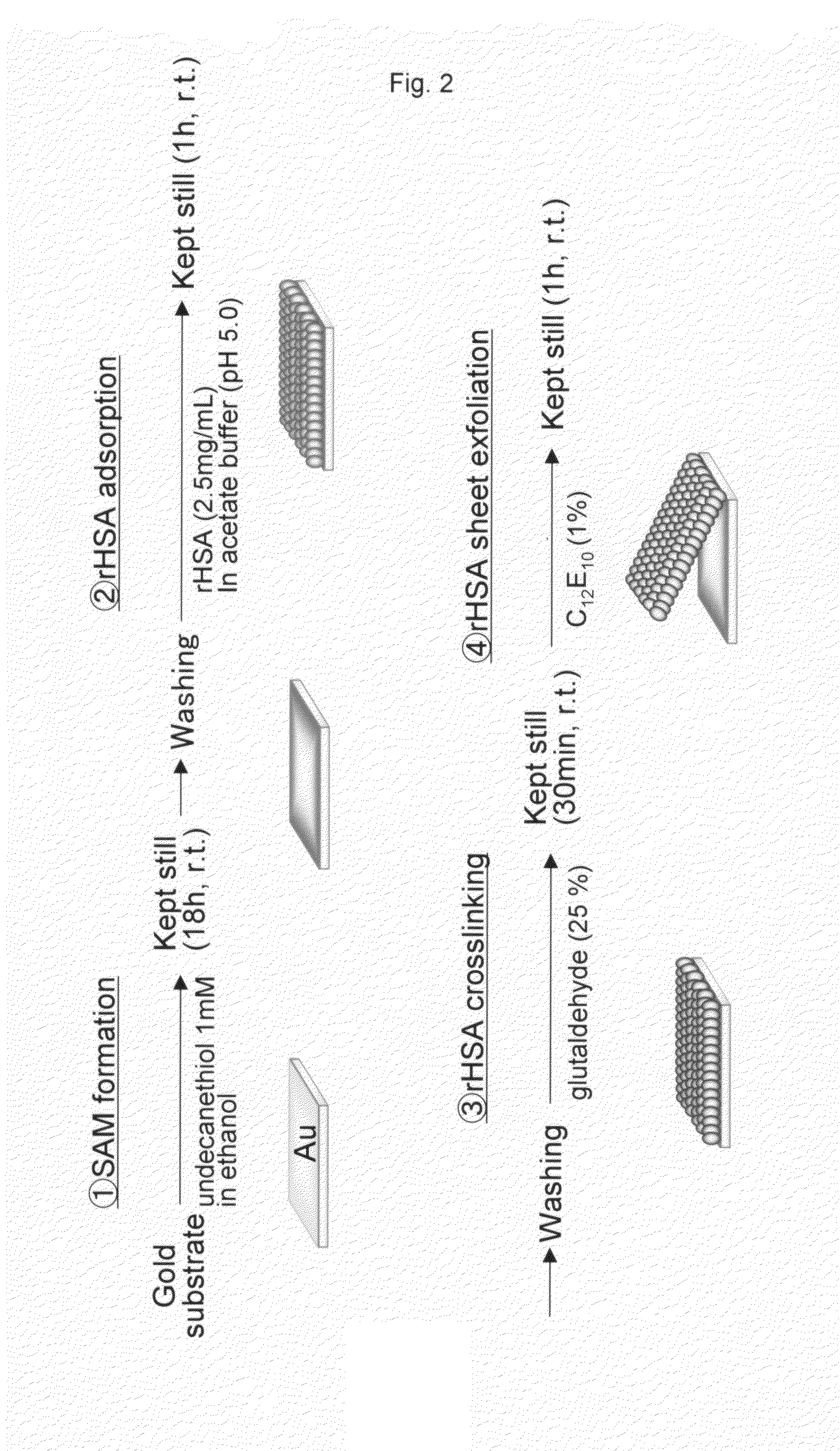Thin-Filmy Polymeric Structure and Method of Preparing the Same
a polymer structure and thin film technology, applied in the field of thin film polymer structure preparation, can solve the problems of high equipment cost, inability to easily handle, inefficient lb method, etc., and achieve the effect of high precision of molds having complex shapes, high cost and high production efficiency
- Summary
- Abstract
- Description
- Claims
- Application Information
AI Technical Summary
Benefits of technology
Problems solved by technology
Method used
Image
Examples
example 1
Preparation of an Albumin Nanosheet
[0137]In this example, an albumin nanosheet was prepared in the following steps (FIG. 2).[0138](1) Formation of a SAM
[0139]A gold substrate was immersed in an ethanol solution of 1 mM undecanethiol and kept still at room temperature for 18 hours, thereby forming a SAM. Next, the SAM-formed gold substrate was washed.[0140](2) rHSA (recombinant human serum albumin) adsorption
[0141]The washed SAM-formed gold substrate was immersed in an acetic acid buffer of 2.5 mg / mL rHSA (pH 5.0) and kept still at room temperature for 1 hour, thereby causing the rHSA to adsorb to the SAM. Next, the substrate was washed.[0142](3) rHSA crosslinking
[0143]The washed substrate was immersed in a 25% (v / v) glutaldehyde and kept still at room temperature for 30 minutes, thereby crosslinking the rHSA.[0144](4) rHSA sheet exfoliation
[0145]The substrate on which the rHSA was crosslinked was immersed in a 1% (v / v) polyoxyethylene 10-lauryl ether (C12E10) and kept still at room ...
example 2
Measurement of a Contact Angle at each Step of Preparation of the Albumin Nanosheet
[0146]Regarding three samples obtained at each of the steps of preparation of the albumin nanosheet in Example 1, i.e., (a) after the SAM formation, (b) after the rHSA adsorption, (c) after the rHSA sheet exfoliation, the contact angle of water drops with respect to the substrate was measured. The results were (a) 73±4°, (b) 35±6°, and (c) 70±4°, respectively (FIG. 3). However, when the rHSA adsorption step (step (b)) was performed in a PBS (phosphate buffered saline) solution of rHSA (pH 7.4), the contact angle was 72±5° and the rHSA was not caused to adsorb.
[0147]Accordingly, it was confirmed that the rHSA was caused to adsorb in step (b) and was completely exfoliated in step (c).
example 3
Measurement of the adsorbing amount of rHSA using a quartz oscillator microbalance method
[0148]A gold-vapor deposited quartz oscillator was immersed in an ethanol solution of 1 mM undecanethiol, thereby forming a SAM on a surface of the gold. The washed oscillator was immersed in an aqueous solution of rHSA (pH 5.0 buffer solution), and a change in the number of oscillations (ΔHz) of the quarts oscillator was measured. FIG. 4 shows a graph illustrating the result of the frequency change. It is clear from FIG. 4 that the number of oscillations was changed by 86 Hz. Considering that a 1 Hz change of the number of oscillations corresponds to the adsorption of 0.86 ng of rHSA, it was calculated that 74 ng of rHSA adsorbed. Next, the number of molecules of rHSA which adsorbed was calculated. From the average surface area (31 nm2) of one molecule of rHSA, the ratio of the surface of the gold which was covered with rHSA was roughly calculated to be 83%.
PUM
| Property | Measurement | Unit |
|---|---|---|
| diameter | aaaaa | aaaaa |
| size | aaaaa | aaaaa |
| pH | aaaaa | aaaaa |
Abstract
Description
Claims
Application Information
 Login to View More
Login to View More - R&D
- Intellectual Property
- Life Sciences
- Materials
- Tech Scout
- Unparalleled Data Quality
- Higher Quality Content
- 60% Fewer Hallucinations
Browse by: Latest US Patents, China's latest patents, Technical Efficacy Thesaurus, Application Domain, Technology Topic, Popular Technical Reports.
© 2025 PatSnap. All rights reserved.Legal|Privacy policy|Modern Slavery Act Transparency Statement|Sitemap|About US| Contact US: help@patsnap.com



